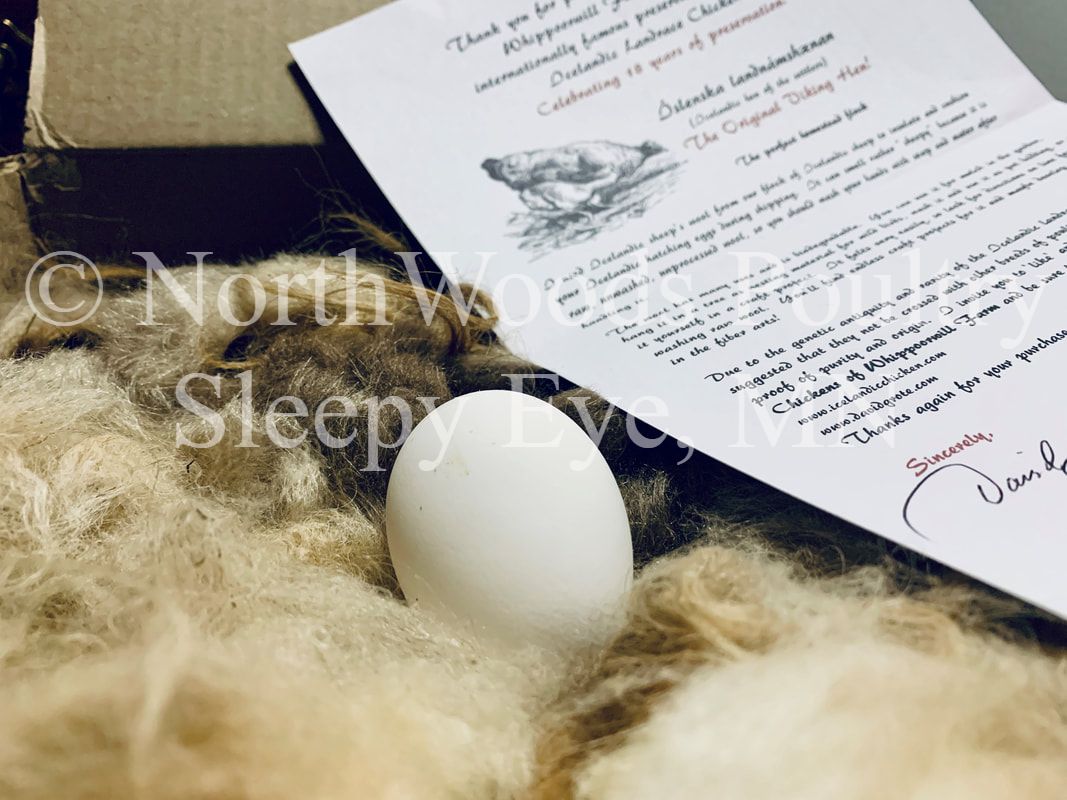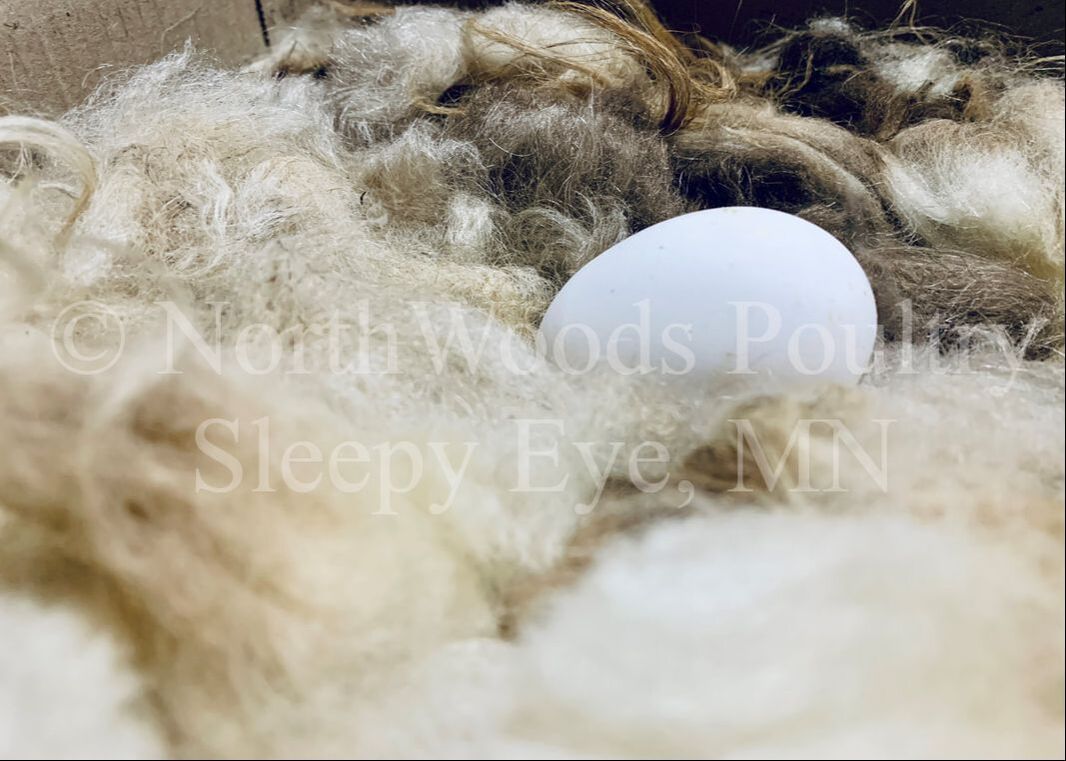Our foundation flock is sourced directly from David Grote of Whippoorwill Farm and contains all four of the original importer lines:
- Behl Line: Developed by Lyle Behl, this line is often referred to as the Kolsholt Line and came from the Kolsstaðir Farm in 2003.
- Hlésey Line: This line is synonymous with Lallemand and Bentley from the Hlésey Farm. It’s also considered an import. The Whippoorwill Farm manages the Lallemand import.
- Húsatóftir Line: Also known as Vala’s line, after Vala Withrow of the Húsatóftir Farm.
- Sigrid/Steiner II: This line is also often referred to as the Steiner II line because it originated from the Steiner II and Syðstu Fossum Farm and was developed by Sigrid Thordarson in 1997–1998.
Conservation Status: "Threatened"
About
The Icelandic chicken is a landrace with the local name of Landnámshænan (settlers’ chicken). Being a landrace means that it has adapted to the natural environment and climate over a long history in the area. In fact, selection goals have been geared towards survival and maintenance of production during harsh circumstances, rather than increased production or standardization of appearance. These birds are often known as “Icies” in America.
Origin & History
Believed to have arrived with Norse settlers from 874 CE and into the tenth century. Indeed, ancient sagas mention chickens, suggesting that settlers brought them along from Scandinavia. It is unknown whether further imports have mixed in with the ancestral lines. However, Iceland’s policy prohibiting imports has reduced this eventuality, although a few foreign breeds are present in the country.
Ancient landraces of cold-hardy livestock have played an important role in rural Icelandic economies. However, the Laki Fissure volcanic eruption of 1783 and the ensuing famine severely diminished all livestock populations. Then in the 1930s, the native chickens’ role in commercial production was replaced by higher yielding imported strains. As a result, there was a drastic drop in the Icelandic heritage chicken population, endangering the survival of the breed.
Fortunately, some smaller farms favored the local landrace. Small numbers survived, but it became more difficult to find fresh blood for breeding. In 1974–5, agricultural scientist Dr. Stefán Aðalsteinsson was working on the Agricultural Research Institute’s livestock conservation project. He collected birds that were representative of the landrace population from various locations in Iceland. An agricultural college managed these birds’ descendants, which were later distributed to breeders and chicken keepers from two farms. A survey in 1996 revealed that more than half the nation’s 2000–3000 Icelandic chickens originated from these flocks. In recent years, public interest in keeping Icelandic chickens has increased. The Owner and Breeder Association (ERL), established in 2003, encouraged new interest in its aim to protect and promote the breed.
Ancient landraces of cold-hardy livestock have played an important role in rural Icelandic economies. However, the Laki Fissure volcanic eruption of 1783 and the ensuing famine severely diminished all livestock populations. Then in the 1930s, the native chickens’ role in commercial production was replaced by higher yielding imported strains. As a result, there was a drastic drop in the Icelandic heritage chicken population, endangering the survival of the breed.
Fortunately, some smaller farms favored the local landrace. Small numbers survived, but it became more difficult to find fresh blood for breeding. In 1974–5, agricultural scientist Dr. Stefán Aðalsteinsson was working on the Agricultural Research Institute’s livestock conservation project. He collected birds that were representative of the landrace population from various locations in Iceland. An agricultural college managed these birds’ descendants, which were later distributed to breeders and chicken keepers from two farms. A survey in 1996 revealed that more than half the nation’s 2000–3000 Icelandic chickens originated from these flocks. In recent years, public interest in keeping Icelandic chickens has increased. The Owner and Breeder Association (ERL), established in 2003, encouraged new interest in its aim to protect and promote the breed.
Conservation
The FAO records 3200 females and 200 males in Iceland in 2018, but exact numbers are not known. Due to the severe reduction in numbers suffered, the gene pool has substantially reduced. As a result, the effective population size (number of individuals effectively contributing genes to the next generation) is as low as 36.2. Conservationists set 50 as the minimum effective population size for short-term survival. Therefore, we need to avoid inbreeding and use a higher proportion of breeding males to avoid extinction.
The inbreeding coefficient is high (0.125), as is inevitable in a small population of isolated animals and common in rare breeds. Nevertheless, the Icelandic chicken has retained a reasonable level of genetic diversity. Furthermore, their unique genes and hardy traits offer an important contribution to the global gene pool and merit conservation. Genetic studies indicate a relationship with Northwest European breeds. However, studies as yet are too few to uncover their origins. Exported lines, such as those in America, represent an even smaller gene pool, so extra care is necessary to select unrelated birds for breeding.
The inbreeding coefficient is high (0.125), as is inevitable in a small population of isolated animals and common in rare breeds. Nevertheless, the Icelandic chicken has retained a reasonable level of genetic diversity. Furthermore, their unique genes and hardy traits offer an important contribution to the global gene pool and merit conservation. Genetic studies indicate a relationship with Northwest European breeds. However, studies as yet are too few to uncover their origins. Exported lines, such as those in America, represent an even smaller gene pool, so extra care is necessary to select unrelated birds for breeding.
Physical Description
Small head with short broad beak and orange or yellow brown/green eyes, short neck, and compact body with high, mobile tail. Shanks are long, often yellow, but can be other colors, and are clean of feathers. Hens may have small spurs, while roosters are long and upturned. Dense, smooth feathering in a wide variety of colors and patterns. Crests are common. Roosters have long, curved sickle feathers.
SKIN COLOR: White. Earlobes are white or pale yellow, sometimes with red streaks. Red wattles and comb.
COMB: Normally single, but other types common.
POPULAR USE: Dual purpose, but mainly eggs.
EGG COLOR: White to pale beige.
EGG SIZE: Small–medium, about 1.75 oz. (49–54 g).
PRODUCTIVITY: Around 180 eggs per year, laying well during winter months. Good fertility. Hens brood well and make excellent mothers.
WEIGHT: Roosters 4.5–5.25 lb. (2–2.4 kg); hens 3–3.5 lb. (1.4–1.6 kg).
SKIN COLOR: White. Earlobes are white or pale yellow, sometimes with red streaks. Red wattles and comb.
COMB: Normally single, but other types common.
POPULAR USE: Dual purpose, but mainly eggs.
EGG COLOR: White to pale beige.
EGG SIZE: Small–medium, about 1.75 oz. (49–54 g).
PRODUCTIVITY: Around 180 eggs per year, laying well during winter months. Good fertility. Hens brood well and make excellent mothers.
WEIGHT: Roosters 4.5–5.25 lb. (2–2.4 kg); hens 3–3.5 lb. (1.4–1.6 kg).
Temperament & Adaptability
Lively, curious, and independent. If raised by calm people, they become friendly. Each bird has a distinctive personality and they are great fun to watch and associate with. They fly well and love to perch in trees.
Self-sufficient and thrifty birds that forage at range. Their habit of scratching through decomposing matter helps them to find nourishment during winter. They need space to thrive and fare poorly in confinement. A long history in Iceland has equipped them for cold, damp climates, and they adjust to others, as long as they are provided with shelter from heat, cold, and rain. Although they are outstanding as cold-weather chickens, combs and wattles may get frostbite in very low temperatures. Outdoor living and selection for hardiness, rather than for increased production, has endowed them with robust health.
Self-sufficient and thrifty birds that forage at range. Their habit of scratching through decomposing matter helps them to find nourishment during winter. They need space to thrive and fare poorly in confinement. A long history in Iceland has equipped them for cold, damp climates, and they adjust to others, as long as they are provided with shelter from heat, cold, and rain. Although they are outstanding as cold-weather chickens, combs and wattles may get frostbite in very low temperatures. Outdoor living and selection for hardiness, rather than for increased production, has endowed them with robust health.

